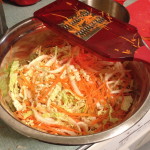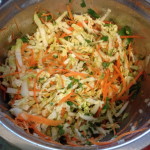This Meatless Monday, we’ve got a recipe for Spicy Napa Cabbage Slaw, as well as growing, storage and preparation tips for Asian greens (bok choy, tatsoi, and Napa, or “Chinese,” cabbage) from our Vermont Fresh: A Fruit and Vegetable Handbook.
Lila Rees, a volunteer cooking, tasting and testing recipes out of the Vermont Fresh Handbook worked on this one. Her comments are below in italics.
Meatless Monday Recipe: Spicy Napa Cabbage Slaw
Serves 4
(adapted from Ruth Cousineau: Gourmet, August 2008 and epicurious.com)
Ingredients
- 1 small head Napa cabbage
- 2 carrots
- ¼ cup rice vinegar (or another kind of vinegar)
- 1 teaspoon ginger (powdered or fresh ginger, peeled and grated)
- 2 tablespoons vegetable oil
- 1 small onion, finely chopped
- 1 chili pepper, finely chopped
- ½ cup cilantro, chopped
- 2 teaspoons sugar or maple syrup
- Salt and pepper
- Photo courtesy of Lila Rees
- Photo courtesy of Lila Rees
Instructions
- Cut the base off the cabbage, remove any damaged outer leaves, and slice into thin strips.
- Shred carrots with grater or vegetable peeler.
- Mix together remaining ingredients to make a dressing.
- Toss cabbage and carrots with dressing and chill for an hour or more. Serve cold.
Notes from Lila:
The recipe calls for “one small head” of Napa cabbage, but they only had GIANT heads, so luckily I was able to get someone at the store to cut one in HALF for me. They were $1.99 lb and it was about 1.5 pounds.
I have a well stocked pantry, so I happen to have everything else on hand. I only used half of an average sized onion, as I am not a big fan of raw onion, I was afraid the onion would overpower everything else. It was the perfect amount for me.
I am particular about the sizes and appearance of my food, so I julienned the carrots to match the thin slices of cabbage. I let the dressing marinate on the salad overnight, it was more on the sweet side, with a touch of heat at the end. This would be a nice side dish in summer (I tried this in Dec), alongside grilled meats or veggies.
It makes A LOT of salad, so I ended up using the leftovers in a miso soup, threw some of the salad in the crock pot with some stock and miso and it was great.
Background
“Asian Greens” is a general term for several leafy vegetables that originated in eastern Asia, including bok choy (also called pac choi), tatsoi, and Napa (or “Chinese”) cabbage. While these vegetables have been used in Asian cuisine for centuries, they are starting to become more popular in the West, too. Tatsoi and bok choy are very similar, both growing in loose heads with long, succulent stems and dark green leaves. Napa cabbage, which resembles an oblong version of the more familiar European cabbage, forms a tight head and has wrinkly, thick-veined leaves. Many more Asian greens exist (such as komatsuna, mizuna, and mibuna), and while their tastes and textures differ, almost all can be prepared similarly.
Growing Tips
Asian greens tend to be fairly hardy, making them a great crop for spring and fall. Tatsoi is especially cold-tolerant, able to withstand temperatures below 20°F. Asian greens are commonly added to salad blends, in which case the leaves are cut when the plants are immature. Mature plants will yield heads of varying sizes. Seeds can be transplanted or directly sowed, but transplanting is recommended to grow full heads in the early season. For baby greens, harvest when leaves are 3-4 inches tall. For full heads, be sure to leave plenty of room between plants. Hot temperatures can cause plants to bolt prematurely, so try to avoid growing full heads in midsummer. Many Asian greens are susceptible to attacks from flea beetles, which can be fended off by protective row cover.
Storage
Heads of tatsoi and bok choy will keep in the fridge for several days if washed, dried, and loosely wrapped in a plastic bag. Napa cabbage will store much longer. Individual leaves and sliced cabbage will only stay fresh for a few days, so use as soon as possible. For long-term storage, tatsoi and bok choy can be blanched in water and frozen. Napa cabbage has traditionally been made into kimchi and canned or refrigerated for long-term preservation.
Nutritional Benefits
Asian greens are notable for their high calcium content. Calcium is important for the body to build strong, healthy bones. Asian greens are also high in vitamins A and C and various phytochemicals that are believed to help boost the body’s resistance to cancer.
Preparation
Avoid choosing greens with yellowing or wilted leaves. Napa cabbages should have firm, tight heads that are free of worm holes and major blemishes. Wash your greens and shake or spin dry. The sturdier the green, the longer it can be cooked (napa cabbage being quite sturdy, tatsoi being more fragile). Asian greens can be steamed, boiled, sautéed, stir-fried, or eaten raw. Try slicing and adding to salads for extra crunch and flavor. Take care not to overcook, as that will diminish flavor and texture.
To receive more recipes and tips on your favorite fruits and vegetables, download Vermont Fresh: A Fruit and Vegetable Handbook. We also need more volunteer home chefs for this project.
Vermont Foodbank fresh food initiatives would not be possible without your support. Please consider giving to the Vermont Foodbank today!



